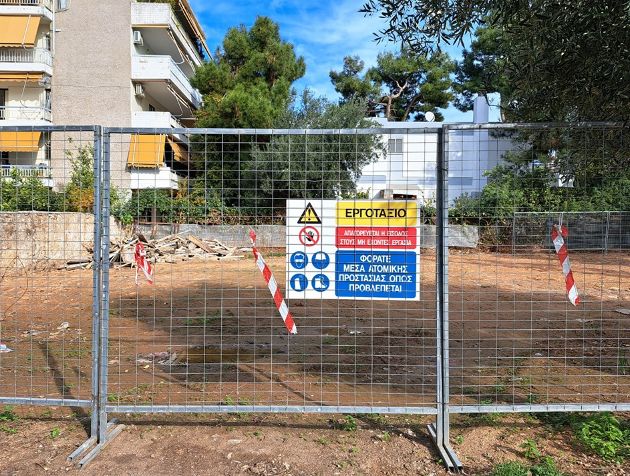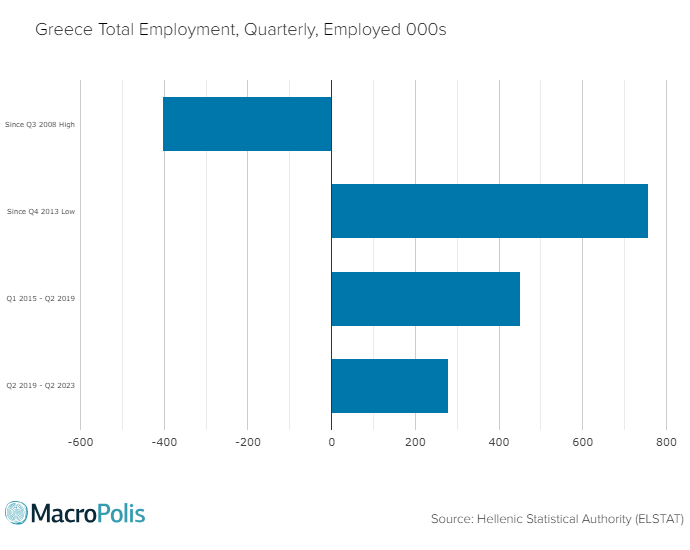How Greece reduced its unemployment rate to less than 10 pct

One of several indicators that captured the pain suffered by the Greek economy because of the debt crisis and the adjustment programmes is the unemployment rate.
In just four years, the monthly rate reached a staggering 28 pct in the summer of 2013. It was at 10 pct at the end of 2009, just as the debt crisis began to unfold, after reaching a low of 7.1 pct in May 2008.
The unemployment rate fell below 10 pct in the latest ELSLAT release for October, landing at 9.6 pct. It was one more indication that Greece is gradually leaving behind the most gruelling period for its economy.
We used employment data from the quarterly labour force survey, which is more granular, to track this path to recovery and evaluate any shifts in the Greek labour market.
The quarterly low in Greek employment was in the last quarter of 2013, with 3.48 million Greek in jobs, compared to a high of 4.64 million workers in Q3 2008.
Based on the latest available quarterly data for Q2 2023, since the 2023 low the Greek economy has put close to 757,000 people back into jobs. The employment figure is at 4.24 million workers.
This suggests that Greece is still 403,000 jobs short of the 2008 high. The Greek labour market is also well short of the 4.51 million employed when the quarterly unemployment rate was at the same level back in 2009.
Given the profile of the Greek economy towards services and specifically tourism, it comes as no surprise that most of the jobs added since 2013 were in the accommodation and food services sector. An additional 162,800 jobs have been created in these sectors. Tourism is due to break the 2019 record of receipt and has fully recovered following the pandemic.
This was followed by 97,000 more jobs in manufacturing and almost 83,000 in wholesale and retail. The health sector and social work activities have seen 90,000 more people in employment, while transportation and storage account for 58,200 more jobs.
It is notable that the construction sector has barely moved, with just 3,600 more jobs since the 2013 low, while when compared to the 2008 high, the construction sector has 244,000 fewer workers, more than half of the total gap.
Another laggard in job creation is wholesale and retail, which have nearly 142,000 fewer workers compared to 2008, followed closely by manufacturing with 132,700 fewer people in employment.

The labour developments in construction and commerce fully reflect the property market’s difficulties, which saw prices drop by 40 pct and construction investment plumet. Private spending was affected severely by the loss of disposable income during the crisis.
There are interesting signals when looking at the developments in the labour market by nationality as even during the recovery period, there are close to 100,000 fewer foreign workers in Greece at 169,700, compared to a rise of almost 800,000 more Greeks in employment.
There are also more than 200,000 fewer foreign workers compared to the 2008 high, when 389,000 foreign nationals were in employment in Greece.
There is certainly a link between foreign workers and the construction sector as it offered employment opportunities snapped up by immigrants in the run-up to the debt crisis.
Combined with the 11,500 fewer workers in agriculture, this trend is what is largely driving the recent public debate about a shortage of hands in building and farming, pushing the Greek authorities to explore deals to bring in workers from African and Asian countries.
The latest census for 2021 by ELSTAT shows a significant drop in foreigners, with some 100,000 fewer Albanians, 40,000 fewer Bulgarians and almost 20,000 fewer Romanians compared to the 2011 census.
The New Democracy administration received most of the positive coverage in recent weeks as the single-digit unemployment rate came while it was in office. However, it is worth noting that the worst unemployment rate in the country’s history, when it reached 28 pct, was also when a conservative-led government was in power. This was another unwelcome entry in ND’s record book, after the centre-right party also oversaw the unravelling of Greece’s public finances in the build-up to the debt crisis.
Since Kyriakos Mitsotakis took office in the summer of 2019, the Greek economy has created more than 280,000 jobs. This suggests that the majority of the recovery in the labour market took place during SYRIZA’s 2015-2019 tenure, when 452,000 more Greeks found jobs compared to the 2013 low.
 Podcast - Whose property? Greece’s housing challenges
Podcast - Whose property? Greece’s housing challenges Can the Green Transition be just?
Can the Green Transition be just? Where is Greek growth coming from?
Where is Greek growth coming from? Bravo, Bank of Greece
Bravo, Bank of Greece